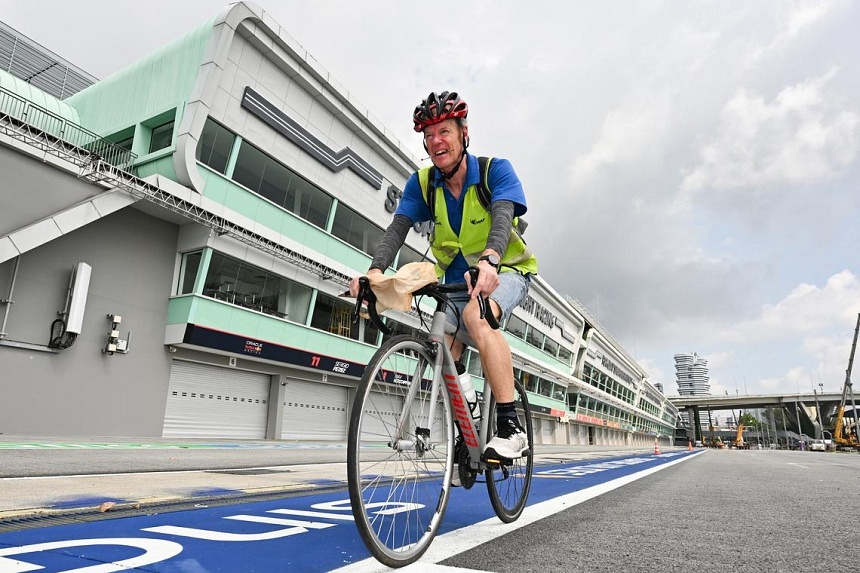He ensures the StanChart Singapore marathon route is 42.195km, but why do runners' GPS watches show more?


SINGAPORE — Over the past 12 years, Kim Vivian has completed at least 50 marathon courses. But instead of running, the Australian travels these routes on his bicycle.
The 60-year-old is not your typical marathon runner; he is a course measurer who clocks many hours and kilometres, determining the length and course of various races around the world.
A month before the Nov 29-Dec 1 Standard Chartered Singapore Marathon (SCSM), the Perth native was in the Republic, working the course in the sweltering heat.
Explaining the significance of his role, Vivian said: "All the events that I measure, all the courses, then get registered on an international database.
"Then anybody can use my events to then qualify for (events like) the Boston or New York Marathon, which have got qualifying times, because they are recognised international quality events."
This complex process begins with Vivian using Google Maps to measure the route, before he gets to work on the actual courses in the respective countries.
One of the first things Vivan does in Singapore is setting up a calibration course, which is typically 300 metres long.
Then he gets on his bicycle and rides up and down the calibration course four times. A counter affixed on his bicycle records the number of revolutions the wheel (counters) makes across a certain distance.
From there, he will be able to figure out how many of these rotations make up 1km, which will then be used to measure the distance of the course.
But Vivian does not complete the required 42.195km distance in one go. Instead, armed with a clipboard and reflective vest, he covers the race route in shorter segments, recording data at each point as he goes along the course.
 The complex process begins with using Google Maps to measure the route, before Kim Vivian gets to work on the actual courses in the respective countries.
The complex process begins with using Google Maps to measure the route, before Kim Vivian gets to work on the actual courses in the respective countries.It is a physically demanding task that sometimes sees him cycling 50km to 60km a day.
Once he is done, he calculates the distances of these different sections of the course to see if any amendments are required.
To the layman, it may seem easier to use a Global Positioning System (GPS) watch.
But he noted: "GPS watches are fantastic, but they are accurate to within 1 per cent. What we're there doing is 0.1 of a per cent out."
That is part of the reason why the distance shown on runners' GPS watches is slightly more than the distance of the course.
Another is because Vivian's job is to ensure that the shortest possible route on the course is 42.195km, but participants may not be able to do so when they are running with many others on race day.
His job involves a lot of numbers, but it is right up Vivian's alley, as the former structural civil engineer loves calculations and spreadsheets.
An avid runner, he first got to know about race course measurers while participating in an event in Perth about 12 years ago.

Intrigued, he expressed his interest in it and started seriously measuring courses after his retirement a decade ago. He went on to earn his C-grade qualification, which meant he could measure but not certify a course.
This marked the start of his journey as an Association of International Marathons and Distance Races (Aims)-World Athletics course measurer.
He became a B-grade measurer in 2016, which allowed him to certify courses, and obtained the A-grade qualification five years later.
As a result, he is qualified to measure courses at events such as the Olympics and world championships.
One of the highlights of his job is the opportunity to travel around the world.
He said: "It's just been a long journey getting up all the different levels. But it's been good fun. I've learnt a lot, meet a lot of good people, see a lot of good courses.
"I would've never been to a lot of places if I hadn't been doing this."
One of his most memorable experiences was in 2021, when he went to Karachi, Pakistan, to measure a course. It was his first visit to the city and he found himself in a unique situation.
One of the first things the race organiser told him when he got to the hotel was, "Whatever you do, do not leave the hotel. You might get kidnapped, anything could happen", he told The Straits Times.
The next day, he was accompanied by police escorts, "two big guys with big machine guns" in an armoured vehicle, as he went about his job.
He said: "Looking back now, it was quite good fun to help Pakistan get a marathon on their map... hopefully get more and more runners into it."
Santoz Kumar, general manager of Singapore for SCSM organisers The Ironman Group, praised Vivian's work, saying: "It upholds our commitment to accuracy and credibility, and ensures our World Athletics Gold Label Race meets the highest international standards.
"With this, we can truly celebrate runners' achievements on a globally recognised stage."
ALSO READ: 30 marathons in 30 days: Briton tests his stamina to raise funds for rare disease
This article was first published in The Straits Times. Permission required for reproduction.